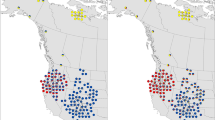Abstract
We developed forensic nuclear SNPs for the side-necked turtle, Phrynops geoffroanus, using next-generation sequencing-based genotyping. We created a reduced-representation library for 23 individuals representing four previously identified lineages of P. geoffroanus using the ddRAD methodology for sequencing on the IonTorrent PGM. We analyzed the sequence data using the Stacks pipeline. We found 811 loci containing 1380 private SNPs. Of these, 473 were fixed in lineages 1, 2 and 3, or with frequency >0.91 in lineage 4. Seventy-three SNPs could be useful for forensics purpose (assignment of individuals to lineage of origin) using traditional PCR-based genotyping methods.


Similar content being viewed by others
References
Arif IA, Khan HA, Bahkali AH et al (2011) DNA marker technology for wildlife conservation. Saudi J Biol Sci 18:219–225. doi:10.1016/j.sjbs.2011.03.002
Avise JC (2004) Molecular markers, natural history and evolution, 2nd edn. Chapman and Hall, Sunderland
Bour R (2008) Global diversity of turtles (Chelonii; Reptilia) in freshwater. Hydrobiologia 595:593–598. doi:10.1007/s10750-007-9244-5
Catchen JM, Amores A, Hohenlohe PA et al (2011) Stacks: building and genotyping loci de novo from short-read sequences. G3 Genes Genomes Genet 1:171–182. doi:10.1534/g3.111.000240
Gibbons JW, Scott DE, Ryan TJ et al (2000) The global decline of reptiles, Déjà Vu amphibians. Bioscience 50:653. doi:10.1641/0006-3568(2000)050
Iyengar A (2014) Forensic DNA analysis for animal protection and biodiversity conservation: a review. J Nat Conserv 22:195–205. doi:10.1016/j.jnc.2013.12.001
Kearse M, Moir R, Wilson A et al (2012) Geneious basic: an integrated and extendable desktop software platform for the organization and analysis of sequence data. Bioinform Appl Note 28:1647–1649. doi:10.1093/bioinformatics/bts199
Martínez JG, Caballero-Gaitán SJ, Sánchez-Bernal D et al (2016) De novo SNP markers development for the neotropical gilded catfish Brachyplatystoma rousseauxii using next-generation sequencing-based genotyping. Conserv Genet Resour. doi:10.1007/s12686-016-0584-1
Moll D, Moll EO (2004) The ecology, exploitation and conservation of river turtles. Oxford University Press, New York
Páez VP, Morales-Betancourt MA, Lasso CA et al (2012) V. Biología y Conservación de la Tortugas Continentales de Colombia. Serie Recursos Hidrobiológicos y Pesqueros Continentales de Colombia. Instituto Alexander von Humboldt, Bogota, Colombia
Peterson BK, Weber JN, Kay EH et al (2012) Double digest RADseq: an inexpensive method for de novo SNP discovery and genotyping in model and non-model species. PLoS One 7:e37135. doi:10.1371/journal.pone.0037135
Rueda-Almonacid JV, Carr JL, Mittermeier RA et al (2007) Las Tortugas y los Cocodrilianos de los Países Andinos del Trópico. Editorial Panamericana, Formas e Impressos, Bogota, Colombia
Sambrook J, Russell D (2001) Molecular cloning: a laboratory manual, 3rd edm. Cold Springs Harbor Laboratory Press, Cold Springs Harbor
Schneider L, Ferrara CR, Vogt RC, Guilhon AV (2011) Nesting ecology and nest predation of Phrynops geoffroanus (Testudines, Chelidae) in the Guaporé River of the Brazilian and Bolivian Amazon. Chelonian. Conserv Biol 10:206–212. doi:10.2744/1071-8443-10.2.206
van Dijk PP, Iverson JB, Rhodin AGJ et al (2014) Turtles of the world, 7th edition: annotated checklist of taxonomy, synonymy, distribution with maps, and conservation status. In: Rhodin AGJ, Pritchard PCH, van Dijk PP, et al. (eds) Conservation biology of freshwater turtles and tortoises: a compilation project of the IUCN/SSC tortoise and freshwater turtle specialist group. Chelonian Research Monographs, vol 5(7), pp 329–479. doi:10.3854/crm.5.000.checklist.v7.2014
Vogt RC (2008) Amazon turtles. Grafica Biblos SA, Lima
You FM, Huo N, Gu YQ et al (2008) BatchPrimer3: a high throughput web application for PCR and sequencing primer design. BMC Bioinform 9:253. doi:10.1186/1471-2105-9-253
Acknowledgments
This work was supported by the SISBIOTA/Conselho Nacional de Desenvolvimento Científico e Tecnológico/Fundação de Amparo à Pesquisa do Amazonas (CNPq/FAPEAM/SISBIOTA-BioPHAM) Grant No. 563348/2010 to IPF; CNPq Ciencia sem Fronteiras Project No. 400771/2013-6 to RCV; and Mohamed bin Zayed Species Conservation Fund Project No. 1025921 to RCV and VTC. We thank the Instituto Chico Mendes de Conservação da Biodiversidade for collection permits (ICMBio, processes 22885-1 and 43175-2). All specimens used were deposited in the Collection of Amphibians and Reptiles of the Instituto Nacional de Pesquisas da Amazonia. We are grateful to Enedina Nogueira of the Laboratório de Tecnologias de DNA for technical support during sequencing. VC was supported by Bolsa de Pesquisa scholarship from FAPEAM during his Doctoral studies in the Biodiversidade e Biotecnologia/Rede BIONORTE Program in the UFAM. IPF and TH were supported by a Bolsa de Pesquisa scholarship from CNPq during this study. JGM was supported by postdoctoral scholarship from CAPES in the MBT program of UEA.
Author information
Authors and Affiliations
Corresponding author
Ethics declarations
Conflict of interest
The authors declare that they have no conflict of interest.
Electronic supplementary material
Below is the link to the electronic supplementary material.
12686_2016_626_MOESM1_ESM.txt
Supplementary material 1. Online Resource 1 Command line script file used for running Stacks pipeline programs components (process_radtags.pl, denovo_map.pl and populations.pl) for de novo SNPs genotyping across all individuals (Lineages 1, 2, 3 and 4) of the side-necked turtle Phrynops geoffroanus (TXT 2 KB)
12686_2016_626_MOESM2_ESM.txt
Supplementary material 2. Online Resource 2 SUMSTATS (summary statistics) file from Stacks pipeline (populations.pl) showing the loci, SNP position in the tag loci, population source, most frequent allele, alternative allele, frequency of the most frequent allele, number of individuals from which the SNP was recovered, heterozygosis for each one of the final 73 recovered SNPs from the Lineages 1, 2, 3 and 4 of the side-necked turtle, Phrynops geoffroanus (TXT 6 KB)
Rights and permissions
About this article
Cite this article
de Carvalho, V.T., Martínez, J.G., Hernández-Rangel, S.M. et al. Giving IDs to turtles: SNP markers for assignment of individuals to lineages of the geographically structured Phrynops geoffroanus (Chelidae: Testudines). Conservation Genet Resour 9, 157–163 (2017). https://doi.org/10.1007/s12686-016-0626-8
Received:
Accepted:
Published:
Issue Date:
DOI: https://doi.org/10.1007/s12686-016-0626-8




